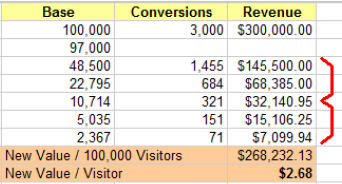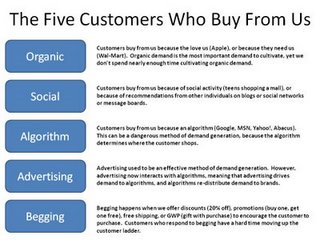If you’ve been following my (roughly) monthly posts on Jason Falls’ blog you know that I’ve taken this tack: On his blog I cover the key concepts of a particular web analytics approach, then provide additional support for that idea here.
A recent example is from two months ago. I posted about the use of Brownie Charts as a way to report Content Interest Index. I posted a parallel piece here on another use of the technique (Using Brownie Charts to Measure Bounce Rates). You could say this blog has become my laboratory: Results of preliminary experiments are described here, while the “real” story is broken on Jason’s blog. Tomorrow will be a little different.
Tomorrow, on Jason’s blog, I’ll be posting on someone else’s innovation. It is a review of an extraordinary book: Hashtag Analytics. I’m a huge fan of its author, Kevin Hillstrom, and over the years I’ve spent way too many hours creating Excel-driven models in order to replicate and fully understand his findings.
I’ll be doing that again, this time in support of Kevin’s approach to monitoring Twitter communities. Check back at this tag (hashtag-analytics) to read updates on my “lab work.” Ill be reporting over the next several weeks.
When A Hashtag Community Member Is “Removed”
You may want to check Kevin’s blog as well — especially later this week, when Kevin reports on the future vitality of the hashtag community #measure. He posted about it last week. Now he plans to theoretically whack an active member. Here’s an excerpt from his post, where he invites readers to suggest whom to “remove”:
In every e-commerce company, somebody is responsible for forecasting sales for the next twelve months, by day. So it makes logical sense that any community manager would want to know what the future of his/her community is, right? This is something you don’t find in any of the popular Twitter-based analytics tools. This is my focus. This is what I love doing, it’s completely actionable, and it’s an area of analysis not being explored!
Next week [the week starting January 24 — that’s today!], we’ll do something neat — we’ll remove one important user from the community, and we’ll see if the absence of the individual harms or helps the future trajectory of the community. If you are an active participant in the #measure community, please send me a user_id that you’d like to see removed in the forecast … I’ll run an example for the individual who gets the most votes.
And in two weeks, we’ll compare the #measure community to the #analytics community … competing communities doing similar work … which community is forecast to have a stronger future?
It’s a fun stunt / modeling experiment that has real world implications. It should serve as a proof of sorts of the predictive power of his Hashtag Digital Profiles and the statistical work behind them. More relevant to online community managers, it should illustrate why showing your participants “love,” lest they never return, is of tremendous importance.
What To Expect Here
I will be applying my own Hashtag Analytics to a different online group — one that has the advantage of weekly meetings. It’s a fairly new group, so the rules may not fully apply (Does an acorn sprout follow the same natural laws of growth as a full-grown tree?). To ensure I don’t jinx my test or influence the community — in a far more direct way than Heisenberg was referring to — its identity will remain unknown until I’ve gathered and analyzed a critical mass of data.
Do stop back.
January 25, 2011 Update:
Here are two related links I didn’t have yesterday. The first is Kevin’s post where he removes that member to the #measure Hashtag community. The second is my review of his book today on Jason Falls’ blog:

